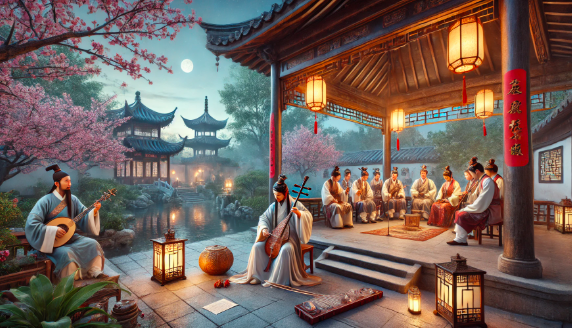
Introduction
Gugequshi is a unique and ancient form of musical storytelling that has been an integral part of Chinese cultural heritage for centuries. This traditional art form combines music, poetry, and narration to tell stories that captivate audiences while preserving history, folklore, and communal values. Throughout its evolution, Gugequshi has adapted to changing times while remaining a crucial element of China’s artistic landscape.
Historical Background
The origins of Gugequshi can be traced back to ancient China, where oral traditions played a significant role in passing down knowledge, myths, and moral lessons. Initially performed in village gatherings and royal courts, this storytelling form evolved with the influence of different dynasties. During the Tang and Song Dynasties, it gained prominence as a form of entertainment for both nobility and commoners.
However, like many traditional art forms, Gugequshi faced challenges, particularly during the Cultural Revolution, when many cultural expressions were suppressed. Fortunately, efforts to revive and protect this tradition have ensured its survival into the modern era.
Cultural Significance
Gugequshi serves as a bridge between generations, offering insight into the beliefs, struggles, and triumphs of ancient Chinese societies. Its narratives often include tales of heroism, romance, and morality, providing audiences with both entertainment and valuable life lessons.
Key Cultural Roles of Gugequshi:
- Preserving Oral History: Many historical events and traditions have been recorded through Gugequshi performances.
- Community Bonding: Performances often take place during festivals and gatherings, strengthening social ties.
- Moral Education: The themes of Gugequshi often highlight virtues such as loyalty, bravery, and wisdom.
Musical Elements
Gugequshi is deeply intertwined with traditional Chinese music, making use of various instruments that enhance the storytelling experience. Each instrument contributes a unique sound that adds depth and emotion to the performance.
| Instrument | Description |
|---|---|
| Dizi | A bamboo flute that produces melodic and soothing sounds. |
| Erhu | A two-stringed fiddle known for its expressive tones. |
| Gu | A traditional Chinese drum used for rhythm and dramatic effects. |
| Yangqin | A hammered dulcimer that adds harmonic richness to the music. |
Storytelling Techniques
Gugequshi follows distinct storytelling techniques that blend spoken word with music. The stories often follow a structured format, beginning with an introduction that sets the stage, followed by a series of escalating events leading to a climax and a moral resolution. Performers use expressive gestures, varying vocal tones, and rhythmic pacing to engage their audience.
Common Themes in Gugequshi Stories:
- Legendary Heroes: Tales of warriors and noble figures who shaped history.
- Romantic Tragedies: Stories of star-crossed lovers facing societal barriers.
- Folklore and Mythology: Narratives featuring deities, spirits, and supernatural elements.
Performance Practices
Traditionally, Gugequshi performances were held in open courtyards, temples, and festival stages, allowing large audiences to gather. The attire of performers is often elaborate, reflecting the historical period or theme of the story being narrated. Audience interaction is also a key component, with spectators encouraged to participate through clapping, singing along, or engaging in dialogue with the performer.
Challenges and Resilience
Like many traditional arts, Gugequshi has faced threats of decline due to modernization, lack of interest among younger generations, and political upheavals in the past. The Cultural Revolution severely impacted this art form, as many traditional performances were deemed outdated and suppressed. However, cultural preservation efforts by artists and scholars have played a crucial role in reviving Gugequshi. Institutions and folk art associations have taken steps to document performances, train new generations of artists, and integrate Gugequshi into school curriculums.
Modern Adaptations
Despite its ancient roots, Gugequshi has adapted to modern times. Contemporary artists are incorporating new musical styles, digital media, and theatrical elements to make performances more appealing to younger audiences. Additionally, Gugequshi has found its place in films, television dramas, and music festivals, expanding its reach beyond traditional settings.
Learning and Transmission
The transmission of Gugequshi has traditionally been an oral practice, passed down from master to apprentice. However, in modern times, institutions and academies have started offering formal training programs. Many young performers are now learning Gugequshi through recorded lessons, workshops, and online platforms.
Ways Gugequshi is Taught Today:
- Apprenticeship System: Learning directly from a seasoned storyteller.
- Educational Institutions: Schools and universities incorporating it into their arts programs.
- Online Platforms: Digital courses and video tutorials making it accessible globally.
Global Influence and Recognition
Gugequshi, while deeply rooted in Chinese tradition, has gained recognition beyond its homeland. Cultural exchange programs and international festivals have introduced this art form to a global audience. Additionally, collaborations between Chinese and Western musicians have led to fusion performances that blend Gugequshi with other storytelling traditions worldwide.
Conclusion
Gugequshi remains a testament to the power of storytelling and music in preserving cultural heritage. Despite facing challenges, this ancient tradition continues to thrive through adaptation and dedicated preservation efforts. As new generations embrace its beauty and significance, Gugequshi is set to remain a cherished part of China’s artistic legacy for years to come.
RELATED ARTICLES
2025 Chevy Suburban Has 6 Trim Levels Ontario Barrett: A Complete Guide
The Ultimate Guide to Husziaromntixretos
Understanding the Coyyn.com Economy: A Comprehensive Guide
Exploring News TheAmericanSecrets.com: A Comprehensive Insight into America’s Hidden Narratives






